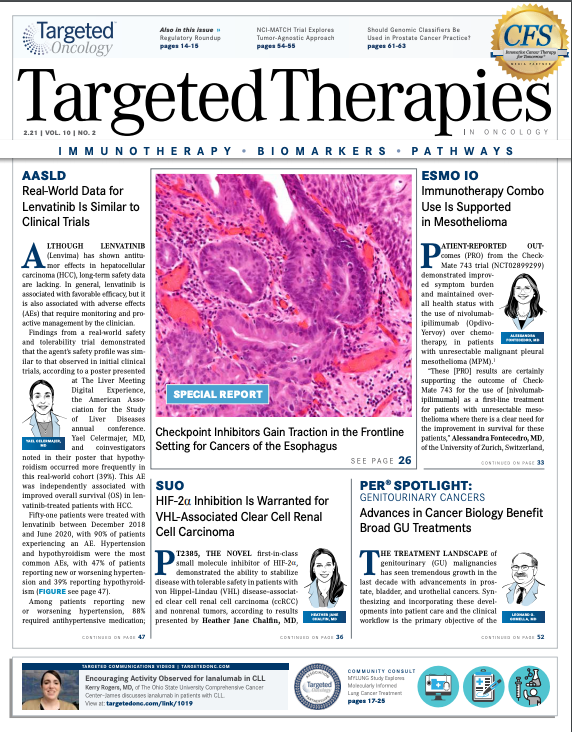NCI-MATCH Trial Explores Tumor-Agnostic Approach
A tumor-agnostic approach in which treatment is developed based on a tumor’s genetic and molecular features without regard to the cancer type or primary tumor location in the body, is the focus of the National Cancer Institute -MATCH trial.

A tumor-agnostic approach in which treatment is developed based on a tumor’s genetic and molecular features without regard to the cancer type or primary tumor location in the body, is the focus of the National Cancer Institute (NCI)-MATCH trial (NCT02465060). Investigators from the Eastern Cooperative Oncology Group-American College of Radiology Imaging Network (ECOG-ACRIN) Cancer Research Group and NCI1,2 sought to determine whether therapy could be better targeted if oncologists could identify molecular alterations using next-generation sequencing (NGS) and administer currently available approved or experimental drugs—either singly or in combination—tailored to those targets. Results of this umbrella/basket trial were published in the November 2020 issue of the Journal of Clinical Oncology.3
“The objective of this study was to determine whether matching drugs targeted against a specific gene abnormality would be effective in treating patients [with cancer] with that mutation, regardless of their tumor type,” said Lyndsay Harris, MD, in an email interview with Targeted Therapies in Oncology. Harris is the associate director of the Cancer Diagnosis Program, Division of Cancer Treatment and Diagnosis at NCI in Bethesda, Maryland, and one of the study report’s coauthors.
The MATCH trial comprised 30 parallel, single-arm, phase 2 subprotocols. Each subprotocol, or arm, featured a different molecular marker-treatment pair. Patients with tumor alterations that could be addressed by a targeted treatment were assigned to the corresponding arm, irrespective of tumor histology. For example, subprotocol H (EAY131-H) investigated the selective BRAF inhibitor dabrafenib (Taflinar) and the MEK1/2 inhibitor trametinib (Mekinist) in patients with BRAF V600–mutant cancers.4
A database that catalogs mutations associated with different tumor types already exists. However, this database, The Cancer Genome Atlas, concentrates on primary tumors that could potentially respond to surgery, either alone or as part of a broader treatment regimen. MATCH, on the other hand, enrolls patients who have relapsed/refractory advanced or metastatic disease.5
Major Findings From MATCH
Nearly 6000 adults have enrolled in the multiarm trial. Eligible patients could have any solid tumor, lymphoma, or myeloma that either had progressed despite standard therapy or for which no curative treatment was available. Other inclusion criteria were an ECOG performance status of 1 or better and adequate hematopoietic, kidney, and liver function.
Patients were required to submit a tumor biopsy specimen obtained within 6 months of study registration. A total of 5540 biopsy samples were sequenced.3,5
Of the 5540 patients screened, 38% had tumors that harbored actionable mutations and 18% were assigned to treatment arms. Of the assigned patients, 70% (n = 686) were ultimately enrolled in a subprotocol arm and received treatment. The accrual goal for each subprotocol was at least 31 eligible patients; as of November 2020, 11 subprotocols had reached this goal.3 Currently, 11 trial arms are open and recruiting patients (TABLE).6
There were 4 major findings from the study:2
- The proportion of patients who had gene abnormalities that matched targeted drugs was 37.6%.
- Uncommon cancers had some of the highest match rates.
- Many patients’ tumors had more than 1 genetic driver of cancer growth.
- Genetic defects exhibited surprisingly little change between primary and metastatic tumors.
It's noteworthy that the trial established the feasibility of sequencing large numbers of tumors in a short time frame. The speedy return of results will enable targets to be identified in time for therapy decisions, according to Harris.
Most Frequent Mutations Not Necessarily Actionable
The most frequently found mutations were in TP53 (47.4%), KRAS (21.2%), and APC (12.4%). Among co-occurring mutations, the pair with the highest incidence was KRAS and TP53, in 12.1% of tumors.3 Despite their frequency, some of the most commonly observed mutations were not actionable; when MATCH was initiated, there were few drugs targeting cancers with KRAS mutations, for example. As a result, there was no subprotocol for this patient segment.7
For many common molecular subsets, though much is known, there remains the need to develop actionable therapies.7 Among the actionable alterations, PIK3CA (11.8%) and PTEN (6.3%) were the most common. All other actionable mutations occurred in 3% or fewer of patients.3
Implications for Targeted Therapy
Although targeted therapies were not currently available for many of the patients’ tumors, this study does have important implications for targeted therapy approaches. MATCH demonstrated that genomic sequencing will reveal targets of interest in a substantial proportion of patients, Harris pointed out, adding, “As we move into an era of more extensive sequencing, it is certain that additional targets will be discovered.” Additionally, Harris noted that a large number of mutations that could lead to treatment resistance was identified in many tumor types, which may explain why some of the study arms had lower response rates.
“We know that melanoma has a high percentage of patients with BRAF mutations,” said April K.S. Salama, MD, a medical oncologist at Duke Cancer Center in Durham, North Carolina, and an investigator on subprotocol H, during an interview with Targeted Therapies in Oncology.8 Targeted therapies have led to significant improvements in patient survival and outcomes, and they have been shown to be effective therapies for melanoma.
“While we’ve seen these great response rates in melanoma and some other cancers, like thyroid cancer, we’ve seen relative resistance in cancers like colorectal cancer that, despite having BRAF mutations and despite getting these highly selective BRAF and MEK inhibitors, showed relatively little benefit and pretty low response rates. And [the inhibitors were] felt not to be all that effective,” Salama said. “And that’s where a trial like MATCH and others like it come in.”
According to Salama, these types of studies can flip the traditional cancer trial, for which a patient must have a certain cancer type to enroll. Instead, MATCH enrolled patients based on certain molecular features. Although there was uncertainty about whether this one-size-fits-all approach would be feasible with BRAF mutations and whether the same drugs would be efficacious in different cancers, her subprotocol study produced positive findings. “It provided further data to suggest that inhibiting BRAF may be an effective strategy against the majority of BRAF-mutated cancers.” Salama acknowledged that her study included only approximately 30 patients, and pointed to interest in expanding the research.
As noted above, one important finding from MATCH was an average match rate of nearly 38% between genetic alterations and targeted therapies. Rather moderate match rates were found in the most common cancers: non–small cell lung cancer (NSCLC; 17.4%), colorectal cancer (13.7%), breast cancer (17.8%), and prostate cancer (23.0%). Cancers with assignment rates more than 25% included central nervous system cancer (37.2%), urothelial cancer (36.0%), cholangiocarcinoma pancreaticobiliary cancer (25.9%), cervical cancer (28.4), gastroesophageal cancer (27.8%), melanoma (26.3%), uterine cancer (26.2%), and anal cancer (25.5%). The lowest actionability rates were found in pancreatic cancer (5.8%), small cell lung cancer (5.1%), and lymphoma (5.0%).3
The second important finding was that some uncommon cancers, such as cholangiocarcinoma, pancreaticobiliary, gastroesophageal, and cervical, had some of the highest match rates. The most common cancers (breast, colorectal, NSCLC, and prostate) had rates that hovered around 17%. “Although the match rate varied widely across the board, some of the less common/rare tumors had the highest match rates, reflecting the larger number of actionable mutations in those types,” Harris said.
Another important point made by the investigators regarded the study’s utility. Using NGS, they wrote, patients could be triaged to investigational therapies, “provided that a sufficiently large pool of agents is made available.”3
Although much research still needs to be done, Harris explained that these findings should encourage community oncologists to direct patients to further trials. “Oncologists should understand that tumor sequencing in metastatic populations is likely to lead to discovery of a potentially actionable mutation that could provide further opportunities for treatment for their patients,” she said. “Furthermore, in advanced, often heavily pretreated cancer populations, single-agent targeted therapies may not be adequate and combinations of agents may be necessary.” Patients enrolling in clinical trials of such combinations would help the oncology community further develop optimal therapies, which would potentially provide greater benefit to patients.
Another benefit of MATCH was the accessibility of the trial. Support from the NCI's National Clinical Trials Network and Community Oncology Research Program made the study broadly accessible to local communities. “In fact, the majority of the patients came from community sites,” Harris said. “This demonstrates that clinical trials such as these can allow physicians to treat their patients where they live, rather than needing to travel to an academic site, and should be encouraged. The MATCH trial is ongoing and enrolling patients at more than 1100 cancer centers and community hospitals in every state, the District of Columbia, and Puerto Rico.”
Call for More Research
The MATCH trial is just the beginning. “Although we did see a number of study arms that met their primary end point[s] for the study, the majority had lower response rates,” Harris said. “We discovered a large number of resistance mutations in these tumors, suggesting that a single target may not be sufficient for efficacy in a patient with an advanced tumor.” A new study, ComboMATCH, has been launched and will look at combinations of targeted agents. Like the original trial, ComboMATCH will be a signal-seeking study. Although MATCH treatments mostly consist of single drugs, ComboMATCH will test combinations of targeted drugs sup-ported by preclinical in vivo evidence. The principal is to overcome drug resistance to single-agent therapy by developing genomically-directed targeted agent combinations.9 Harris encouraged oncologists to direct patients to clinical trials such as MATCH.
Salama agreed. “We know that many adult patients in oncology are not treated in clinical trials,” she said. “I think continued interest and participation in clinical trials ... is what we really need to advance the field.”
REFERENCES
Liu A. Large genomics study points the way to future cancer clinical trials. Fierce Biotech. October 14, 2020. Accessed January 6, 2020. https://bit.ly/394zU8A
Genomic study of 6000 patients in NCI-MATCH precision medicine cancer trial. ECOG-ACRIN. October 13, 2020. Accessed January 6, 2020. https://bit.ly/39arTii
Flaherty KT, Gray RJ, Chen AP, et al; NCI-MATCH Team. Molecular landscape and actionable alterations in a genomically guided cancer clinical trial: National Cancer Institute Molecular Analysis for Therapy Choice (NCI-MATCH). J Clin Oncol. 2020;38(33):3883-3894. doi:10.1200/JCO.19.03010
Salama AKS, Li S, Macrae ER, et al. Dabrafenib and trametinib in patients with tumors with BRAFV600E mutations: results of the NCI-MATCH trial subprotocol H. J Clin Oncol. 2020;38(33):3895-3904. doi:10.1200/JCO.20.00762
Breindle A. NCI-MATCH data give insights into late-stage tumors. Bioworld.com. October 16, 2020. Accessed January 6, 2020. https://bit.ly/2L7znuD
Flaherty KT, Gray R, Chen A, et al; NCI-MATCH Team. The molecular analysis for therapy choice (NCI-MATCH) trial: lessons for genomic trial design. J Natl Cancer Inst. 2020;112(10):1021-1029. doi:10.1093/jnci/djz245
National Cancer Institute. NCI-MATCH trial (molecular analysis for therapy choice). Accessed January 6, 2021. https://bit.ly/3bkM0x7
Ray T. NCI-MATCH data shows value of platform trials for patients with rare genomically driven cancers. Precision Oncology News. October 14, 2020. Accessed January 6, 2020. https://bit.ly/3okFb25
ECOG-ACRIN Cancer Research Group. Precision medicine cancer trial NCI-ComboMATCH/EAY191. July 2, 2020. Accessed January 22, 2021. https://bit.ly/3ogNsUh

Survivorship Care Promotes Evidence-Based Approaches for Quality of Life and Beyond
March 21st 2025Frank J. Penedo, PhD, explains the challenges of survivorship care for patients with cancer and how he implements programs to support patients’ emotional, physical, and practical needs.
Read More